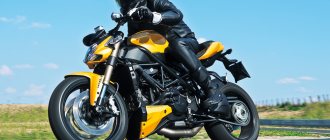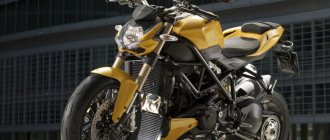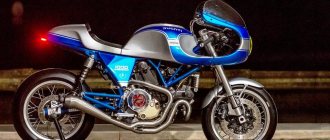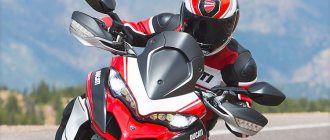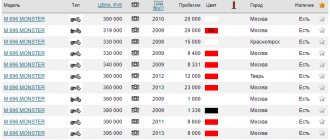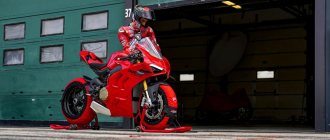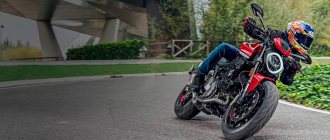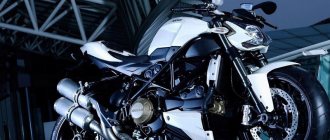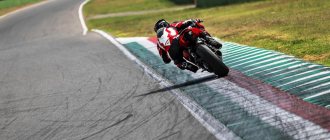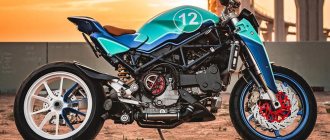A connoisseur's dream. Part 2
In the previous material, we examined in some detail the Ducati sports motorcycles produced from 1993 to 2006. Today, the next step is a story about more modern models and the general technical features of all the motorcycles we are considering.
1098 (2007–2008)
Italian engineers, having experimented with design as much as possible within the 999 model, decided to create something new, but at the same time as recognizable as possible. The 1098 model was such a responsible step, marking the beginning of a new stage in the evolution of the company’s sportbikes.
Only the lazy did not notice how well the designers did their job. The design of the front of the motorcycle has returned to the design with two horizontally positioned headlights. But all optics have changed dramatically towards more complex forms. The plastic has become more streamlined and sharply defined. The motorcycle as a whole looks surprisingly light and harmonious. According to many experts, this is the first aesthetically correct Ducati sportbike since the original Ducati 916.
The heart of the model was the Testastretta Evoluzione engine (at that time the most powerful V-type in history). It developed a record 160 hp. With. at 9750 rpm. The suspension, as expected, is entirely built on the highest quality components with a full range of adjustments. Progressive electronic systems include a data logger, an immobilizer and DTC traction control as an option. These gadgets then migrated to all subsequent models of the company (the 848 did not even have DTC as an option).
The special version 1098S differs from the basic version by the presence of Ohlins components all around, more powerful brakes and carbon fiber. 1098R (2008) is essentially a 1198. There is a traction control system on board, a new engine like the 1198, rear suspension with an Ohlins shock absorber. General TTX at the level of cars from the MotoGP world (180 hp at 9750 rpm). The cladding is made using carbon fiber.
The main problem with the Testastretta Evolusion engine (1098 and 1198) is that due to the fact that the degree of forcing of the piston group has noticeably increased and the increase in the load on the crankshaft supports has become much more significant, the left crankshaft bearing is running out at an accelerated pace. The generator rotor is very heavy (on sports versions this problem is solved by making the rotor lighter) and by the time it runs 40,000–50,000 km it wears out the bearing. The first sign is that the engine begins to howl noticeably. This repair rarely costs less than 100,000 rubles.
Starting with 1098, the overrunning clutch was changed, which caused a lot of problems for owners of “three nines”. Now its resource has risen to 25,000–30,000 km. But, nevertheless, the left side of the crankshaft remained overly loaded - in addition to the weighty generator rotor, there is also an intermediate shaft, which is responsible for the drive belts.
In 1098, 848 and 1198, due to the use of thin, easily bent plastic, the air filter box is steadily screwed in, and dirt from the front wheel begins to fall directly into the engine with all the ensuing features until the death of the power unit. The problem can and should be solved on your own by strengthening and gluing the standard airbox. These troubles appear even on new motorcycles after a year and a half of active use. A little mileage on a crooked box - and you can already plant potatoes on the air filter, but this is a minus for the engine. An insufficiently qualified mechanic who simply changed the filter on such a motorcycle and did not bother to eliminate the defect is also a minus for the engine. Just hoping it won't work, the vacuum in the filter is like in a cool modern vacuum cleaner.
848 (2008–2013)
The 848 is a smaller and more budget-friendly version of the Ducati 1098. The motorcycle is visually very similar to its older brother, but has a number of simplifications - a reduced engine size, simpler brakes and a wet clutch.
In 2010, the regular 848 was replaced by the EVO version. The new motorcycle features more powerful brakes borrowed from the 1098, a non-adjustable steering damper and a significantly upgraded, more powerful Testastretta engine (new cylinder head, cams, pistons, compression ratio increased to 13.2, upgraded fuel supply system).
1,198 (2009–2011)
The 1198 series consists of four different modifications - Ducati 1198, 1198S, 1198S Corse and 1198R Corse. All motorcycles are built around the lightest engine at the time of creation, Testastretta Evolusion 2 (170 hp). Thanks to new crankcase production technology, the weight was reduced by 3 kg. The pistons are taken from the company's racing designs. The Marelli injector is 13.3% more efficient than the 1098. All versions are equipped with the new Ducati Data Analyzer system (a kind of on-board recorder). The 1198S and 1198S Corse are equipped with proprietary traction control as standard, the 1198R Corse has this system as an option.
Visually, 1098 and 1198 are twin brothers. The only differences are in the wheels (the more recent model does not have bifurcated spokes) and the nameplates on board.
1199
Panigale (2011 – present)
The best track motorcycle of the 2000s, the best V2 engine in history (Superquadro), one of the most beautiful motorcycles of our time - and all this is the Ducati 1199 Panigale (Borgo Panigale is a small fishing town in Italy, where the Ducati factory is located). On board is multi-mode traction control (DTS), nine ABS operating modes, three power modes: rain - 120 hp. p., 195 l. With. smoothly, 195 l. With. and a bunch of other electronics and telemetry. A special charm is that the “liter-two hundred” in feel and size (but not in power) is more like a skinny “six hundred”. The engine was largely redesigned and the clutch assembly was immersed in an oil bath. There is no frame as such; the main load-bearing role is played by the engine.
Visually, the motorcycle is as delicate as possible and unlike anything the Italians have produced before. The front fairing was slightly blunted and acquired two bright arrow-shaped headlights, combined with huge air intakes. The side plastic has slightly decreased in size, and the tail unit has become even more compact, mainly due to the fact that the entire exhaust system is now hidden under the belly of the motorcycle, the exhaust gases are released almost under the rear wheel.
Naturally, there is also an S version, which sports electronically adjustable suspension (Öhlins NIX30 fork and TTX-36 shock absorber). Curb weight – 179 kg. A Corsa version with the Italian tricolor and an unusual exhaust will also be available.
In 2014, Ducati began production of the Ducati 1199 Superleggera superbike, a super-light version of the Panigale. The motorcycle with a record power-to-weight ratio is entirely made of super-light materials, with a total curb weight of 155 kg. A total of 500 copies were produced. That same year, a matte black version of the Dark Stealth was introduced. The only differences are in the coloring.
Buying such a motorcycle not for sports use is more of an image move. For civilian use, the motorcycle will not be able to reach its full potential and will require extremely expensive maintenance.
899
Panigale (2013 – present)
899 is obviously a simplified and smaller copy of the adult Panigale. It is based on the same chassis and Superquadro engine. The volume of the power unit is 898 cm3 (148 hp at 10,750 rpm, 193 kg curb weight). The electronics equipment is quite serious: electronic throttle control, a customizable engine control unit ECU (Race, Sport, Wet), an eight-level traction control system and a three-level anti-lock braking system, Engine Brake Control. The stock six-speed Ducati 899 Panigale gearbox with quickshifter is identical to the one found on the Ducati 1199 Panigale. Visually, the new motorcycle is almost a copy of the Ducati 1199 Panigale, with the exception of the usual double aluminum swingarm.
No serious bottlenecks were identified in the two new products due to the insufficient amount of operating statistics, one thing is clear - falling on these motorcycles is extremely expensive! It’s not a fact that the Panigale family will live up to the full scope of the Italians’ hopes, but it has already become a global bestseller.
Modern Ducati sportbikes, in a certain sense, can immediately be considered luxury. Pricing in everything, including ordinary services, differs greatly from its Japanese counterparts. In other words, if you don’t have a sufficient amount of money, it’s better not to get involved in this segment. The relatively budget 848 can be considered an entry ticket. On the secondary market, supply for all models exceeds demand. After all, motorcycles are too much for everyone and it will not be easy to resell them. Service is also a thing in itself.
General technical features
In Russia, we mostly grew up on Japanese sports motorcycles, and some design features of Ducati may at first glance seem at least strange. However, the engineering component of Italian motorcycles is extremely well thought out. Yes, they are not so ultra-reliable, but they cannot be called fragile either. The bottom line is that almost every sports model (and these are the majority) is already in its standard version (and the R version especially) is ready to go on the track and show good results. But for the best racing technologies you have to pay triple the price during maintenance, which is quite natural.
The L-shaped motor is very reliable. The most important condition for its happy, problem-free existence is the proper oil level and timely maintenance. All water Ducatis do not like underheating. It is enough not to warm up the engine three or four times to fill the spark plug of the rear cylinder. Accordingly, it stops working correctly, periodically sneezes loudly and hits the engine in the opposite direction, destroying the overrunning clutch. A few impacts are enough for the clutch to start slipping. The essence of the problem is not in technology, but in heads. If you carefully study the operating instructions, it indicates the intervals for replacing spark plugs, which should, at a minimum, be observed, and, at a maximum, exceeded! Ducati engines are absolutely not demanding on the use of high-tech oils due to the fact that their foundations were laid in those years when no one knew about high-quality lubricants. A wheelie with front wheel lift angles of about 90° is definitely contraindicated for absolutely all Ducati motorcycles. The stopping factor for fans of such sophistications should be the cost of repairs. The gearbox takes care of itself enough that you don’t even think about it at all. Problems with gears not engaging or falling out are rare.
The factory engine cannot be called noisy. Yes, there is a characteristic rustling sound of a dry clutch (on those models that have it), but nothing more. The famous “bucket of nuts” sound is an indicator that it’s time to shake out the clutch. The louder the sound from the imaginary nuts, the greater the wear of the clutches and clutch basket and, accordingly, the closer the tragic ending. Of course, it’s not worth launching, it will cost more.
With sufficient knowledge of the hardware of the timing belt drive, problems do not arise at all. Its maintenance scenario is simple - periodic monitoring with replacement if necessary. The desmodromic drive is adjusted according to the technical documentation (every 12,000 km depending on the model); this work is best left to professionals.
It makes sense for the owner to immediately study in detail the procedure for correctly tensioning the final drive chain, otherwise even the slightest sag due to uneven powerful traction impulses from the engine will quickly lead to increased wear of the chain and sprockets, and will also add unpleasant jerks when starting from a standstill .
Unfortunately, marketing has completely killed the pleasure of service. If in classic models a plastic body kit, made according to sports traditions with quick-release fasteners, can be removed in a matter of minutes, then on modern Ducati sportbikes, in order to disassemble at least something, you need to use all possible skill, and this will not guarantee the success of the operation and the absence of a broken one fasteners The speed and ease of maintenance and repair have dropped many times over time. The plastic of modern Ducatis is a separate problem. Thin and brittle, after a year of operation it is screwed, ceasing to fit normally and losing all the gaps. This is not observed with older motorcycles even ten years later. Here I just want to quote our Ducati guru Zhenya Zheludkov: “The maintainability of motorcycles in old bodies is simply fantastic: disassembling and reassembling plastic takes two minutes, changing spark plugs takes five minutes, changing belts takes 20 minutes.”
Tuning
There is a great variety of tuning and accessories for Ducati motorcycles. The main demand is for aftermarket exhaust systems, various types of styling and cladding parts made of noble carbon fiber. Deep tuning for civilian purposes is extremely rare, mostly serious intervention in the design revolves around preparing the motorcycle for use on race tracks. There are a few large drag bikes known, but these are rather the exception to the general rule. It is important to understand that such aesthetically perfect motorcycles should not be sculpted with just anything. What is typical is that really beautiful and necessary parts cost quite a lot of money already at the stage of purchasing from European sellers.
Application
Naturally, the racing track should be the home of a sportbike, and Ducati sports motorcycles prove this in the best possible way. In general, nothing prohibits moving around the city, but you need to know when to stop. Travel should always have close to ideal asphalt and a minimum amount of traffic congestion. If you are going to use, say, a 916 or 1098 as a motorcycle for every day, and even in rural areas, fear God. Such conditions will negate all the pleasure of riding and significantly shorten the life of the motorcycle.
Crash tests
In terms of vulnerability when contacting asphalt, various obstacles and other road users, modern models (1098, 1198, 1199 and 899) fare somewhat worse than their more robust predecessors. Here, even a slight fall on the spot can cause a lot of problems. The Panigale family even with a moderate impact scatters like firecrackers. The plastic on these motorcycles is much thinner, more fragile and more expensive. The levers, paws and fasteners are as openwork as possible. With every small crash test, the owner is doomed to significant financial losses and a long wait for new parts.
Conclusion
Of course, we must give credit to the Italians, they know how to create beautiful equipment. But, frankly speaking, they were and remain artisans. In terms of bringing existing technologies to perfection, everything is fine, but with the development of new original original designs, conservatism is in its maximum manifestation. Let's take a look at sportbikes. For example, if we take away the absolute masterpieces represented by the Desmocedici (a rare example that goes beyond the material) and Panigale, it turns out that 1198 is still the same 916, but only 17 years later. The motorcycle has simply been changed to suit the context of a specific time; the main components, assemblies and patterns of their interaction are still the same. Only Harley-Davidson can afford to release one successful design onto the market and then upgrade it countless times. Ducati again turned to sports to save the situation. Panigale is definitely a step forward in development, but whether it will help bring back its former glory, we will find out in the very near future.
We express our gratitude to the “Evgeniy Zheludkov Workshop” for their assistance in preparing the material, www.royal-mc.ru, tel. 8 916-087-82-77.
Chic, shine, beauty >
Similar materials
A connoisseur's dream. Part 1
29 July 2014 13:37 Mikhail Pimus
Ducati 1098 review
The Ducati factory has always had something to brag about: motorcycles of this brand annually win the majority of victories in the world Superbike championship. Such simple PR greatly excites the minds of motorsports fans and forces them to spend huge amounts of money on the purchase of sportbikes from this company. The popular Ducati 1098 is a striking example of how, by parting with an amount exceeding a million rubles, you can become the owner of a racing car that has not only an external resemblance to the motorcycles of famous racers, but also a “filling” quite similar to track machines. Despite the fact that the Ducati 1098 is a motorcycle for public roads, in appearance it is practically no different from a professional superbike, clad in racing plastic. The optics on this bike are almost invisible: the narrow strips of headlights barely visible at the front of the fairing, as well as the stylish and almost invisible rear light, make this bike look like it just ran away from the competition. True, the fact that the bike is still “civilian” is eloquently indicated by the passenger footrests with a seat, a license plate holder and mirrors with built-in turn signals. To call the appearance of the Ducati 1098 beautiful is not enough - all the curves and lines are repeatedly “blown” in the wind tunnel and adjusted with maximum precision, so even the beauty in this motorcycle is calculated to the smallest detail. The main thing that can conquer the Ducati 1098 is the two-cylinder Testastretta Evoluzione power unit. Today this is one of the most high-tech L-shapes, which has not only enormous power, but very low weight. The engine is based on a number of technologies that have been tested for many years in the hottest races and fully meet the standards of reliability and modernity. For example, the low weight of the engine is explained by the use of titanium in the piston elements and magnesium alloy cylinder head cover - a truly racing solution. And high power was achieved thanks to the optimally calculated ratio of piston stroke and cylinder diameter (104 x 64.7 mm) coupled with 42 mm intake and 34 mm exhaust valves. Also adding power to the engine are sports camshafts, oval intake manifolds, a Marelli electronic injection system and a symmetrical stainless steel exhaust manifold with titanium couplings. All this allows you to achieve a maximum power of 160 hp. s., which with a motorcycle weight of 173 kg gives simply hurricane dynamics - the Ducati 1098 is considered one of the fastest and most dynamic production sports bikes of our time. The motorcycle frame is also of interest - the size of the pipes varies from 28 to 32 mm, and the pipes themselves have different thicknesses in different places. This technology allows you to significantly reduce the weight of the motorcycle and not overload components where greater rigidity is not required with excess metal. Moreover, tests have shown that in this situation, correctly calculated geometry even made it possible to gain considerable strength. By the way, the unique structure of the frame also influenced the design of the rear suspension - a well-calculated arrangement of the Showa rear monoshock absorber significantly improves the motorcycle’s handling and overcoming bumps. The front suspension has a wide range of adjustments, and the Showa inverted fork with 43 mm travel is coated with titanium oxide - this reduces friction and increases the durability of the seals. Together with the Marchesini steering damper and the excellent Pirelli tires that are fitted from the factory, this gives full control over the behavior of the front wheel and allows for increased cornering speed. Also, the brakes, which are borrowed from the motorcycles of professional athletes, have a great influence on control - these are monoblock four-piston Brembo calipers, paired with discs with a diameter of 330 mm. The discs themselves, by the way, are also unique - they are low in weight and reduce centrifugal force, which makes steering easier and allows effective and measured braking for any driving style and on any surface. The electronics of the Ducati 1098 are a separate story. The usual place of the instrument panel is occupied by a compact liquid crystal screen, which displays all the indicators necessary for the pilot, including a stopwatch for training on the track, ambient temperature and much more. The screen backlight is made brighter or weaker depending on the lighting conditions - you can safely enter tunnels and drive in cloudy weather. Menu functions are switched using buttons on the steering wheel, so you can change the displayed information while driving. In addition to the basic version of the Ducati 1098, modifications with the index R and S are also available. The Ducati 1098S model has Marchesini alloy wheels, an Ohlins 46PRC rear shock absorber and an adjustable Ohlins steering damper, as well as a front fork from the same company. All this made it possible to reduce the weight of the motorcycle by a couple of kilograms relative to the basic version, while leaving the transmission and engine unchanged. In addition, the R and S modifications are equipped with the DDA (Ducati Data Analyzer) system, which allows detailed monitoring of the operation of the motorcycle systems during trips. The information received is sent to a memory unit, then via a USB card to a computer, where data on engine speed, coolant temperature, fuel consumption, distance, speed and much more can be analyzed in detail, right down to the throttle opening angles. Based on the data obtained, you can reconfigure the motorcycle systems, as well as draw conclusions about your own riding style. Also, the modification of the Ducati 1098R carries more global changes, including the power plant. The engine capacity of this motorcycle has been increased by 100 cubic meters, and the ratio of piston stroke to cylinder diameter has changed accordingly - 106x67.9 mm. It is quite obvious that the intake-exhaust system was also reconfigured, after which the motorcycle’s power at the rear wheel reached 180 hp. With. At the same time, even more titanium parts were added to the engine design, the exhaust system was lightened, the passenger seat was removed - and the motorcycle “lost weight” significantly, showing only 165 kg of dry weight on the scales. The gearbox was also reconfigured - the gear ratios are different compared to the base model, and a new Ohlins TTX36 monoshock absorber of a very unusual design was installed in the frame. The use of two pipes in a single block allows you to obtain uniform pressure over the entire range and eliminate the slightest rocking of the motorcycle. And the number of adjustment positions of the TTX36 - and there are as many as 20 of them - will help you adjust the bike to any pilot, any tire and track. Also a key feature of the Ducati 1098R is the presence of the DTC (Ducati Traction Control) option, somewhat similar to the popular YCC-T power control system from Yamaha sportbikes. Only if the Japanese implemented only control of power modes, Ducati engineers went much further: the DTC system controls the speed of rotation of both wheels and, by controlling engine speed, reduces the chance of falling in corners and on a wet track. It also saves inexperienced pilots from mistakes in handling high power and makes it possible to control the motorcycle more predictably in city conditions. There are 8 power modes in total, they can be easily switched with a handle on the steering wheel. To summarize, it can be noted that Ducati 1098 sportbikes are truly legendary motorcycles, they are expensive, require advanced training for piloting and high-quality service. But these are some of the fastest, best-handling and well-designed motorcycles that provide serious competition to Japanese and German vehicles.
Timoshenko Andrey
